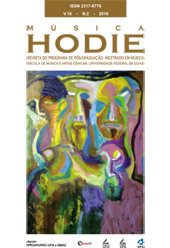Teaching guitar: a comparison of two methods
DOI:
https://doi.org/10.5216/mh.v16i2.45342Abstract
Musical performers have typically been categorized as either “classical” (reading music), or “playing by ear,” (usually popular or folk music). The two groups of musicians were seen at polar opposite ends of a spectrum. The intent of this study was to explore a comparison between traditional teaching from notation (reading group), and another method that focused on ear playing, and imitation of a model (hearing/modeling group), with an intact class of music education majors learning to play the guitar (N=22). A panel four of judges who evaluated each student’s final performance of a mandatory prepared piece without knowledge of their treatment group, scored each individual in five categories: note correctness, rhythmic precision, confidence, expression, relaxation and posture, tone quality, and synchronization between the hands. There was a significant difference in the final performance assessment between the hearing/modeling and reading groups. The hearing/modeling group had higher average scores (M=3.07) than the reading group (M=2.50), as well as higher scores on the specific sub-categories. Training “by ear” seems to have positive effects for accuracy and fluency of performance in beginning guitarists. Keywords: Guitar pedagogy, Guitar teaching methodology, Playing by ear, Reading music.Downloads
Download data is not yet available.
Published
2017-02-13
How to Cite
APRO, Flávio; SIEBENALER, Dennis. Teaching guitar: a comparison of two methods. MÚSICA HODIE, Goiânia, v. 16, n. 2, 2017. DOI: 10.5216/mh.v16i2.45342. Disponível em: https://revistas.ufg.br/musica/article/view/45342. Acesso em: 23 dec. 2025.
Issue
Section
Artigos















